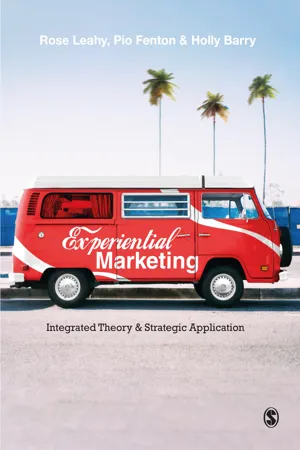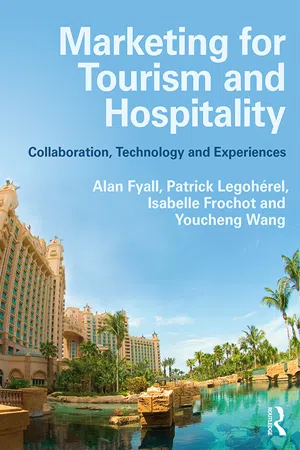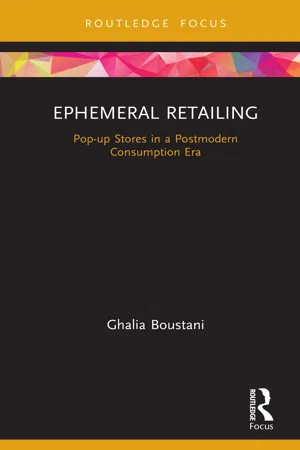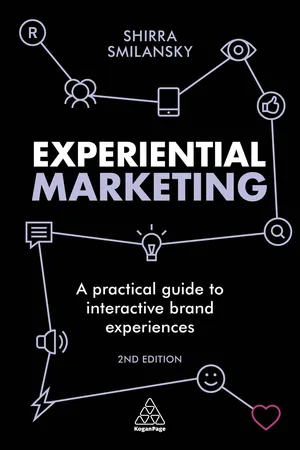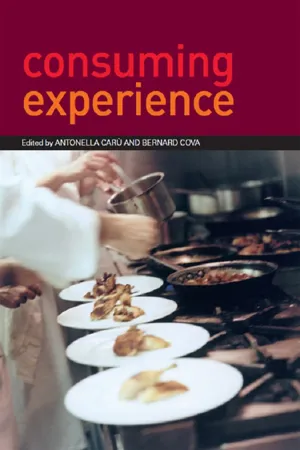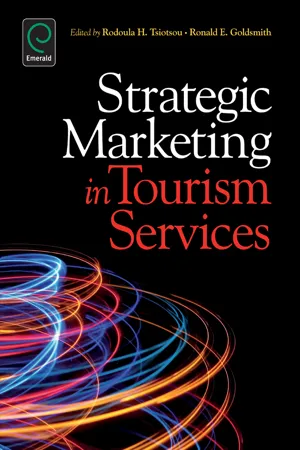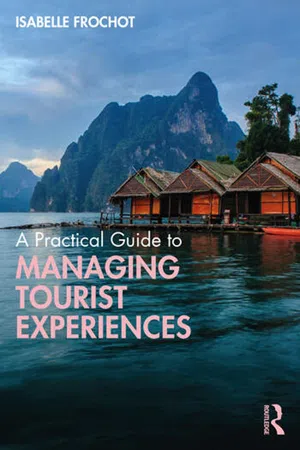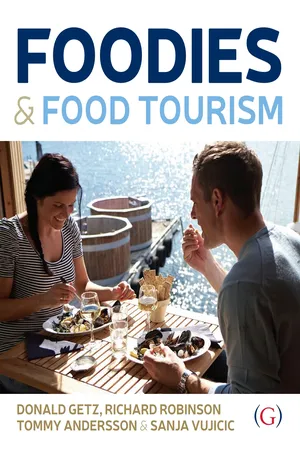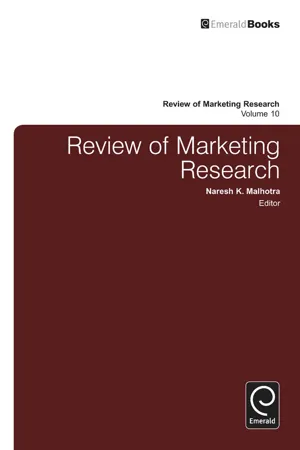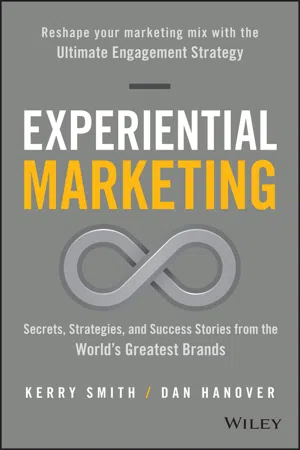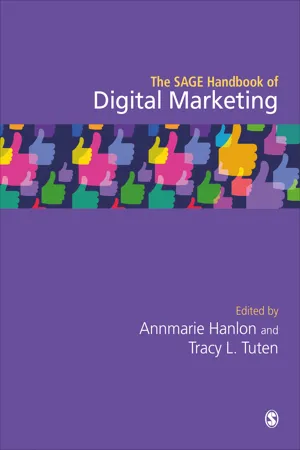Marketing
Experiential Marketing
Experiential marketing is a strategy that focuses on engaging consumers through firsthand experiences with a brand. It aims to create memorable and immersive interactions that leave a lasting impression. By providing opportunities for customers to directly interact with products or services, experiential marketing seeks to build emotional connections and drive brand loyalty.
Written by Perlego with AI-assistance
Related key terms
1 of 5
12 Key excerpts on "Experiential Marketing"
- eBook - ePub
Experiential Marketing
Integrated Theory & Strategic Application
- Rose Leahy, Pio Fenton, Holly Barry(Authors)
- 2022(Publication Date)
- SAGE Publications Ltd(Publisher)
Essentially, Experiential Marketing is an immersive marketing tool, and while there are merits to the implementation of traditional marketing methods 1 in isolation, traditional marketing practices do not typically fulfil brand requirements of building immersive and authentic connections with a brand audience. The reason why this topic is so important is precisely because Experiential Marketing is so impactful when it comes to connection and relationship development. In this chapter, we will discuss the following topics: Experience: We will see that there are differing perspectives on its nature and focus. Experiential Marketing: In presenting definitions of Experiential Marketing, we will work towards a definition that is reflected throughout this book. The interplay between experiential and traditional marketing: This will more clearly position Experiential Marketing as part of a spectrum of marketing activities. Experiential value: Setting the tone for further chapters, we will commence the discussion about the value of Experiential Marketing. What Do We Mean by Experience? Experience is at the heart of Experiential Marketing. Knowing what is meant by experience is key to fully utilising the best possible Experiential Marketing tactics and strategies. Creating a memorable experience for a customer (be they business or consumer) can have the impact of exciting that customer. Exciting the customer creates memory and memory, in turn, creates connection. Multiple authors and practitioners have considered the boundaries and nature of experience over the years, and a general belief now exists that it is intrinsically linked to the human senses – delight consumers through whatever means, tap into their emotions (positively) and give them reason to reflect. In Chapter 2 we provided an initial deep-dive into the theoretical foundations of the concept of experience - eBook - PDF
- Pauline Maclaran, Michael Saren, Barbara Stern, Mark Tadajewski, Pauline Maclaran, Michael Saren, Barbara Stern, Mark Tadajewski(Authors)
- 2009(Publication Date)
- SAGE Publications Ltd(Publisher)
Experiential Marketing thus focuses on the company’s planning and implementation of what it is offering, whilst accentuating the idea that the outcome should be something that is very significant and unforgettable for the consumer living through this experience. In just a few years, Experiential Marketing has changed the status of consumption experi-ences, displacing them from what consumers have personally gone through to participation in a consumption festival dominated by excess, extravagance, magic, spectacularity, and sim-ulation (Carù and Cova, 2007). In fact, there has been a great deal of criti-cism of the limited and planned nature of the marketing experiences, which are very manipulative and predetermined and there-fore meet with resistance from some con-sumers. Indeed, such experiences leave the consumer very little room to really partici-pate in their conception and construction. Consumers only become actors insofar as they are allowed to do this, i.e., when they fulfill their role as a consumer overwhelmed by the experience’s context. Yet, consumers seemingly not only want to be immerged in their experiences but also seek to design and actively produce them. For many consumers, an experience is more than the simple accep-tance of a prepackaged offer revolving around a theme that has been chosen by the firm (thematization of the experience) – some of it must also be left unorganized so that it can become appropriable. A good example of the appropriation of experience in the daily life of our hypermodern contemporaries is the con-sumption of holidays. Seventy percent of all Europeans produce their own holidays. This is a way for them to appropriate their vacations. To an experience that has been organized and planned by the firm, the consumer can oppose a creation of experiences that is very different in nature, one that can be described as the art of living since it is characterized by the art of diverting commercial experiences (de Certeau, 1984). - eBook - ePub
Marketing for Tourism and Hospitality
Collaboration, Technology and Experiences
- Alan Fyall, Patrick Legohérel, Isabelle Frochot, Youcheng Wang(Authors)
- 2019(Publication Date)
- Routledge(Publisher)
6 Experiential Marketing A question of co-creationKey terms Experiential Marketing, experience economy, sensorial marketing, authenticity, storytelling, surprise, involvement, emotionsLearning outcomes By the end of this chapter, students will:- Understand why Experiential Marketing is essential to designing tourists’ experiences
- Acquire a deeper understanding of the main pillars of a successful and memorable experience
- Understand how a tourist experience can be developed
- Appreciate the different service components that can be cultivated to provide a memorable experience.
Introduction
Experiential Marketing is not just a buzzword or marketing’s latest fashion trend. A strong body of literature that aims to investigate how consumers perceive their consumption experience supports Experiential Marketing. It adopts the idea that beyond goods and services, customers are actually looking for an experience where they will live, feel, and sense it rather than just buying and taking home a product/service. Considering that what takes place during the consumption itself is what customers are really looking for has changed our vision of marketing. Whilst traditional marketing vision stands for products and services, in the tourism and hospitality context, it is clear that the experience itself is what consumers have come to seek. And if this experience relies on a physical provision, it is the sensorial and experiential elements that take place during the stay that actually drive consumers.As will become evident throughout this chapter, this vision of marketing has necessitated a re-conceptualization of traditional marketing models, encouraging researchers and managers alike to revise all the concepts involved in the decision and experience process. It is also important to consider that the experience is a longitudinal process that starts well before the experience takes place right through after the consumption of a service, to consider even long-term impacts. Furthermore, it has also been recognized that companies should move away from considering themselves as products and services providers to include the consumer in this process and co-create value with those consumers. - eBook - ePub
Ephemeral Retailing
Pop-up Stores in a Postmodern Consumption Era
- Ghalia Boustani(Author)
- 2019(Publication Date)
- Routledge(Publisher)
Nevertheless, sensory marketing refers to the theatricality of the point of sale having understood that the mere manipulation of some environmental components will not only lead to the objectives related to customer behavioural reactions, but can affect other physiological states (Lemoine, 2004). Sensory marketing is a major player on the emotions of consumers visiting a point of sale; it provides joy, excitement and mood satisfaction (Srinivasan & Srivastava, 2010). It is consequently the activation of the consumer’s five senses. Having taken into account this dematerialised world, retailers pay more attention to triggering customer senses that were neglected until now: hearing, olfaction, taste and touch (Daucé & Rieunier, 2002; Rieunier et al., 2013). The mere manipulation of environmental components was not the finality that the brands wanted to achieve; the purpose of sensory marketing is to design experiential contexts that differentiate the company or the brand. Thus, it was through sensory marketing that the first attempts to enrich the experience at the point of sale took place (Antéblian et al., 2013).Following Pine and Gilmore’s (1999) “Experience Economy” nomination, the experience has become a primary foundation for customers to immerse themselves in extraordinary experiences. The authors explain that the experience is the last stage of completion of a product enriched by a brand and complemented by a service (Antéblian et al., 2013).The existential desire of the current consumer is triggered by Experiential Marketing (Anon., n.d.; Abidi-Barthe & Kaabachi, 2009) that takes into account the importance of the point of sale and the consumer’s interaction with it. An upheaval in the movement from the push strategy to the pull strategy (Ochs & Remy, 2006; Lemoine & Badot, 2010) is rethinking traditional marketing practices that are too focused on supply. With the era of Experiential Marketing, shifting polarity from production to consumption (Aurier, 2005; Ochs & Remy, 2006) was achieved to deliver a co-product value between supply and demand (Ochs & Remy, 2006), following an enhancement of the proposed offer and its presentation.The points of sale must present consumers with multi-sensory provocations; these places are themed, theatrical (Ochs & Remy, 2006) and hyper-real (Antéblian & Filser, 2008; Batat & Frochot, 2014; Badot & Lemoine, 2015). The difference between Experiential Marketing and the production of experience is that the consumer must engage in extraordinary immersions to increase the economic value of mere commodities and transform them into an experience.Experiential Marketing involves making purchases that are impulsive rather than reflective (Andrieu et al., 2004). The customer connects with the brand, a face-to-face interaction that amplifies the essence of the brand (Niehm et al., 2007) into a bundle of tangible, physical experiences and interactive behaviours (Kim et al., 2010). Surprising, spectacular and extravagant sales outlets facilitate the development of an experience; they are not the only medium to achieve the experience. It is not enough for the brand to be themed and theatrical and to create stimulating points of sale. - eBook - ePub
Experiential Marketing
A Practical Guide to Interactive Brand Experiences
- Shirra Smilansky(Author)
- 2017(Publication Date)
- Kogan Page(Publisher)
PART ONE An experiential revolution The accelerating transformation of business and marketingPassage contains an image
01
What is Experiential Marketing?
Experiential Marketing is a methodology, not a channel
Marketing communication messages, through media or other marketing channels, exist to communicate with different consumer groups or business sectors. Marketing communication channels traditionally include: advertising, direct mail, packaging, sales promotion, sponsorship, public relations, digital and live brand experiences. These have all seen rapid transformation as technology accelerates change in the creative industries and ‘Next Gen-ers’ (a mix of millennials and Gen Z) grow up to represent enormous chunks of society’s purchasing consumers and influencers.Integrating your live brand experience
Live brand experiences should not be created in isolation without consideration for how they and their content will translate through other channels. It is always best to explore how to replicate them digitally and integrate them with the rest of your marketing efforts, utilizing and considering the formats of a selection of your available channels to help support its effectiveness. Marketers deploy each channel to achieve different goals and objectives, and each platform has different considerations in terms of how to best produce appropriate content and personalized creative. - eBook - ePub
- Antonella Caru, Bernard Cova(Authors)
- 2013(Publication Date)
- Routledge(Publisher)
Part I Setting up the scene of the consumer experiencePassage contains an image
Chapter 1 Consuming experiences An introduction
Antonella Carù and Bernard CovaDOI: 10.4324/9780203390498-2KEY POINTS- It is through consumption that people build up and reinforce their identities.
- Today consumers seek to experience immersion into thematic settings rather than merely to encounter finished products.
- The production of a consuming experience includes staging, active customer participation, and a narrative.
- Experiential Marketing aims at creating extraordinary experiences for consumers.
- People's daily life is made up of consuming experiences that can occur with or without a market relation.
After the marketing mid-life crisis during the 1980s, many marketers were hoping that the 1990s would involve a refocusing on relationship marketing and customer relationship management (CRM), a solid and innovative concept that highlights the relational sphere and its derivatives. Fifteen years on, this approach appears unfortunately to have gone as far as it can, largely due to marketing's excessive rationalizing of the relationship between firms and consumers. As a result, the discipline is now placing its hopes on the concept of “Experience,” a notion that first arose in consumption and marketing studies in a seminal article written by Holbrook and Hirschman (1982) : “The Experiential Aspects of Consumption: Consumer Fantasy, Feelings and Fun. ” Twenty years later, experience has evolved to become a key element in the understanding of hedonistic consumer behavior. It has also become the main foundation for an experience economy (Pine and Gilmore, 1999) , recently followed by the advent of Experiential Marketing (Schmitt, 1999 , 2003 - eBook - PDF
- Rodoula H. Tsiotsou, Ronald E. Goldsmith, Rodoula H. Tsiotsou, Ronald E. Goldsmith(Authors)
- 2012(Publication Date)
- Emerald Group Publishing Limited(Publisher)
Goldsmith and Rodoula H. Tsiotsou management, arguing that managers should create value by seeing their products as experiences to be managed. In the hospitality and tourism context, experiential motives describe the benefits that tourists derive from learning about, experiencing and recounting their purchases of tourism products and services. As tourism managers learn that they compete with an increasingly growing variety of other tourism services nationally and globally, they must understand the tourists’ motivations so that they can gain competitive advantage by distinguishing and uniquely positioning their offerings and by focusing on experiential benefits to give them this advantage ( Tsiotsou & Ratten, 2010 ). 13.3. Experiential Marketing Several definitions of experiential consumption and Experiential Marketing (or customer experience management, CEM) appear in the literature ( Schmitt, 2010 ), as the chapters in this section attest. One exposition introduces the concept by con-trasting Experiential Marketing with more traditional product marketing. According to Schmitt (2010) , first, product marketing focuses on features and benefits of tangible goods, while Experiential Marketing focuses on customer experiences that occur when consumers encounter, undergo or live through situations that produce sensory, emotional, cognitive and behavioural effects. For example, while product marketers might emphasize the price or cleanliness of their hotel rooms, experiential marketers would stress the look and feel of the room and what it is like to stay there. Second, when product marketing focuses on narrow product categories, Experiential Marketing focuses on the broad situation (and its meaning) in which the products might be used. For example, rather than focus on selling the hotel room, the marketer would emphasize the role played by staying at the hotel in the total experience of visiting the destination. - Isabelle Frochot(Author)
- 2021(Publication Date)
- Routledge(Publisher)
Chapter 5Generating the experience
DOI: 10.4324/9781003019237-6Introduction
In this chapter, we aim to understand how the experiential approach can developed into managerial principles in order to deal with the key components of Experiential Marketing. The six experiential cues detailed in this chapter have been inspired by the work of other scholars and consultants that have developed their own experience models. The first part of the chapter presents those models and resituates the diversity of experiential approaches. The second part of the chapter summarizes the key components and processes that have been identified as contributors to successful experiences. Each of these six cues will be presented, and an exercise and an experience generator guide will be provided to explain in detail each of the cues.5.1 Why was Experiential Marketing created?
Experiential Marketing has developed intensively over the past few decades, especially in the tourism industry. This is a fundamental development, involving a reconsideration of the basics of service delivery, the mechanics of satisfaction and consumer behaviour more generally. Experiential Marketing is also a testament to changing consumer demand. Tired of services perceived as insipid, 21st-century tourists are turning to offers that offer a change from the ordinary, that disconnect them from realities and immerse them in new consumption universes. They long for a reenchantment of their consumption universe and are increasingly in search of unusual and outstanding experiences.5.1.1 Holbrook and Hirschman, pioneers in Experiential Marketing
Experiential Marketing is not in itself a recent phenomenon, since it appeared in the early 1980s with the work of two American researchers, Holbrook and Hirschman. These two authors questioned traditional marketing models, which were based on the conception of rational consumers who sought to maximize their utility through their consumption choices. These so-called traditional models were not really capable of explaining consumption phenomena such as emotional response, sensory pleasure, the playful dimension of consumption, etc. The experiential approach does not propose rejecting categorically traditional models but recommends that, in certain consumption contexts, the observed behaviour responds to different mechanisms. Those specific contexts include leisure, art consumption and tourism. Holbrook and Hirschman (1982) indicated that in those instances, consumers had different patterns of consumption that necessitated the development of new models more appropriate to those dynamics.- eBook - PDF
- Donald Getz, Richard Robinson, Tommy Andersson, Sanja Vujicic(Authors)
- 2014(Publication Date)
- Goodfellow Publishers(Publisher)
They are looking for rewarding and often novel experiences in which their interaction with the combination of food, culture, and terroir helps create and reinforce their personal and group identities, facilitate personal Foodies and Food Tourism 172 development (through learning, mastery, aesthetic appreciation), and gives them a great story to talk about later. Tressider and Hirst (2012: 14) said that experience marketing: “...utilises a set of conventions and approaches that represents events, tourism, hospitality and food in a particular way that has heightened significance within the rootlessness of the post-industrial/modern world ... by elevating the represented experience to that of the ‘extraordinary’ and is in direct opposition to everyday reality.” The profane, or everyday, is contrasted with the extraordinary, or sacred experience that consumers really must enjoy for themselves. While this sacred/profane dichotomy has been used many times to describe the touristic experience in gen-eral, it has special meaning for those in pursuit of authenticity. When it comes to practical applications of experience marketing, Canada’s Province of Nova Scotia has the right idea: (http://www.novascotia.ca/econ/tour-ism/marketing-business/experiences/) access Nov. 26, 2013. Experiential Tourism: Delivering Tourism Experiences Travel is not just about where you’ve been anymore – it’s about what you did while you were there, how it made you feel, the people you met while you were there, and the memories you took home. A product is what you buy; an experience is what you remember. Through crafted experiential tourism opportunities, experiences provide our visitors unique, entertaining, and/or educational activities that make it possible for them to have a personal connection to Nova Scotia and its people. It is about visitors becoming an active participant where they can try a new skill, learn about who we are or how we live, or challenge themselves. - eBook - PDF
- Naresh K. Malhotra(Author)
- 2013(Publication Date)
- Emerald Group Publishing Limited(Publisher)
Another key strategic issue for companies is how to position the corporate brand, and individual product Consumer Experience and Experiential Marketing: A Critical Review 51 brands in a competitive context. For that purpose, many companies perform brand-architecture analyses and commission perceptual maps, which are based on similarity data and analyzed using multidimensional scaling techniques. The maps are usually based on verbal input and dimensions are often generic (e.g., ‘‘high price – low price,’’ or ‘‘high quality – low quality,’’ or ‘‘strong image – weak image’’). The alternative from an experience perspective is the introduction of a customer relevant new concept or a new dimension. Moreover, a creative and innovative implementation theme may be used to execute the new positioning. Finally, innovation is often viewed narrowly as technical innovation, residing in the R&D department. From an experience perspective, however, customers value not just features-and-benefits-oriented technical innovation but also small innovations that simplify their lives as well as design and lifestyle innovations. CONCLUSION At the 2009 Association for Consumer Research Conference, Chris Janiszewski, in his Presidential Address, presented a passionate plea for an increased study of consumer experiences ( Janiszewski, 2009 ). ‘‘So what is our opportunity? In what substantive areas do we, as a discipline, have a special interest and a competitive advantage?’’ he asked. ‘‘The answer is ‘consumer experience.’’’ We agree. And as this review has shown, as a field we have already learned quite a lot about experiences. The topic has been researched from multiple perspectives to gain insight into its multifaceted nature. We have a good understanding of the importance and effects of experience for product and services and in various other settings (e.g., stores and digital environments). - eBook - PDF
Experiential Marketing
Secrets, Strategies, and Success Stories from the World's Greatest Brands
- Kerry Smith, Dan Hanover(Authors)
- 2016(Publication Date)
- Wiley(Publisher)
CONTENT Some of the most effective Experiential Marketing strategies are designed to create content—in many cases, for the rest of the marketing mix. For most brands, the experience has become the greatest and most authen- tic generator and feeder of content. Trade show booths are serving as recording studios for YouTube videos. Keynote presentations at busi- ness‐to‐business events are being captured and redistributed as investor briefings, sales overviews, and employee messages. Entire Super Bowl TV spots are being filmed at events. As one CMO told us: “Who needs an ad agency when you have expe- riential marketing?” Today’s experiential campaigns are serving a variety of content roles. There are 25 types of content that leading brands are extracting from live experiences: • TV Spots. Forget hiring actors and directors. Live experiences provide access to a real audience interacting in a brand experience. • Print, Direct, and Outdoor Ads. Event environments are often so compelling that they can be featured in corporate print slicks, out- door ads, banners, and so on. Developing an Experiential Strategy 43 • Viral Videos. The best viral videos capture random, unscripted moments—and those are the building blocks of events. • Social Media Posts. There are no more content‐rich sources for real‐time or scheduled social media posts than events—they are the ultimate social media content feeders. • Employee Briefings. Conferences and corporate meetings can be streamed or taped and used for internal employee communications. • Executive Roundtables. At C‐level events, putting CEOs in a room for on‐the‐record conversations can be repurposed into press materials, media articles, features, and blog posts. • B‐roll. With so much going on at events, there’s no shortage of con- tent to grab for your PR team’s B‐roll library. • Infographics. Breakout sessions, keynotes, and Q&As provide fresh content for stat‐driven or quote‐based infographics. - eBook - ePub
- Annmarie Hanlon, Tracy L. Tuten, Annmarie Hanlon, Tracy L. Tuten, Author(Authors)
- 2022(Publication Date)
- SAGE Publications Ltd(Publisher)
Similar research indicated satisfied customers of coffee shops have higher levels of intention to revisit and are more likely to talk positively with others about their experience because of those satisfaction levels (Nadiri and Gunay, 2013). These findings support evidence that ExM practices and service quality lead to customer satisfaction through experiential value, which induces positive post-purchase behaviour. To survive in a highly competitive global market, management must consider ExM as a crucial marketing tool.As the pivot from physical to phygital brand experiences has begun, the question is whether a person needs to be physically present for a brand experience to resonate or whether virtual experiences can evoke the same emotions (Eastwood, 2014). Most research connected to customer experience measurement does not dictate how the experience is delivered, or through which ExPro. Instead, the ExM evaluation methods and metrics are aligned within the overall strategic intent and design of the brand experience. Furthermore, continuous evaluation of ExM across all consumer touchpoints eventually enables a brand to identify to what extent those who are physically present at a brand experience feel the same emotions as those who experience a brand virtually.The experiential advantage posits experiential purchases lead to greater individual happiness and well-being than material purchases (Weingarten and Goodman, 2021). Academics have debated whether the experiential advantage is stronger than that associated with a material purchase. Experiences cannot be bought and sold like material goods and choosing one over the other is not a problem which needs to be solved (Schmitt et al., 2015). Instead, life is about experiences, material purchases, and the happiness they bring when they facilitate one another. The effect of the experiential advantage is reduced in some instances, such as when an experience is negative, solitary, experienced by a lower socioeconomic status consumer, or if the experience provides a similar level of benefit relative to material goods (Weingarten and Goodman, 2021).
Index pages curate the most relevant extracts from our library of academic textbooks. They’ve been created using an in-house natural language model (NLM), each adding context and meaning to key research topics.
